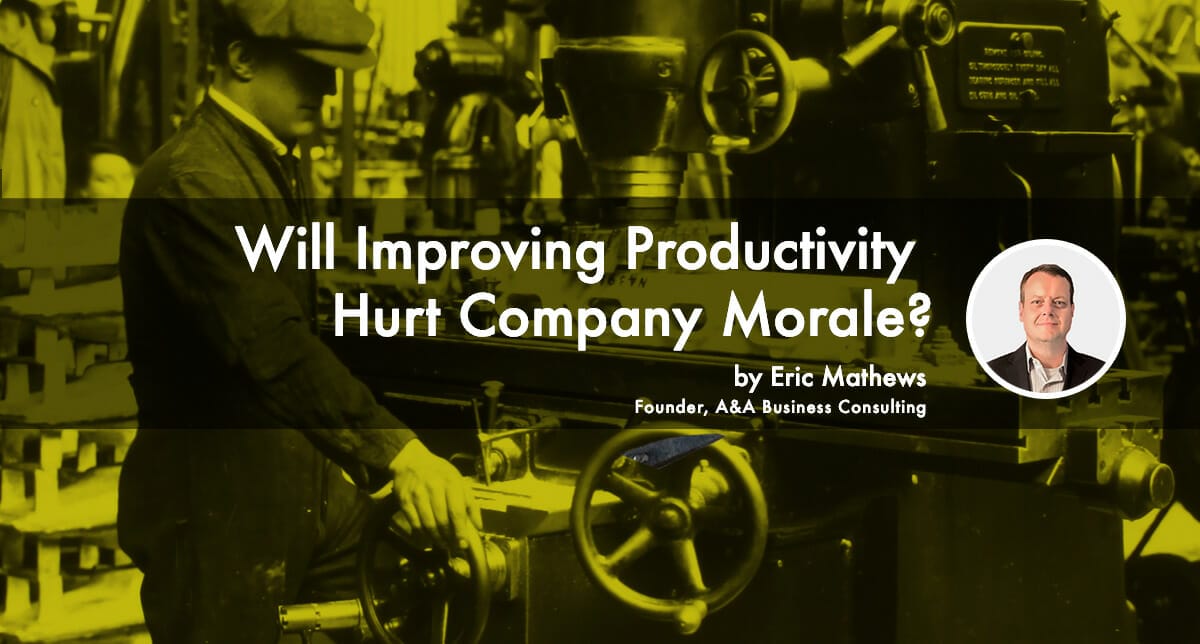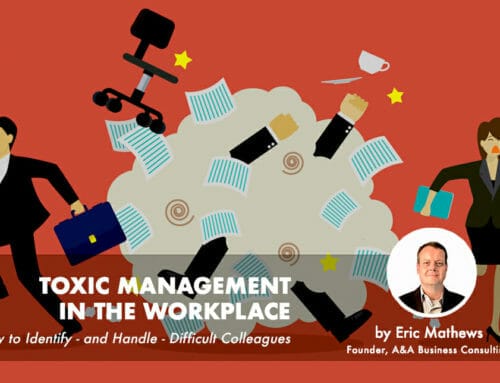The water cooler.
The break room.
Those sacred places in the company where employees congregate to catch up on the latest news, share information, and build enough stamina to get through the day. Necessary…or a waste of time?
When I consult with companies around the world, we often have to address the culprits of lost productivity. This means we look at time wasted in idle conversations, extraneous breaks, and irrelevant interruptions.
Yet some managers worry: “Will eliminating all this wasted time kill morale? Without the water cooler, what do I really have in company culture?”
This blog will show that increasing productivity actually improves company culture.
What defines your culture?
To begin with, you need to take a look at what defines your company’s culture; this will inform employee morale. Is your culture determined by the work your employees do? Or is it determined in the in-between times, when your employees are not working?
Good leaders know that time spent in productive work shapes culture– not the time spent in between assignments.
You’re not killing culture by reducing or eliminating “water cooler” time. You kill your culture when you leave too much room for “water cooler” time. Those wasted minutes (or hours) should not be the defining moments of your culture–your mission, values, and work should be. That’s the purpose of the company. That’s why everyone gets up to come to work in the morning, or should be. Engaged management will be able to direct and communicate the culture through shared work experiences and intentional meetings.
The Vital Employee
Morale can be determined at the group level (i.e., company culture), but it can also be felt on the personal, individual level. Each employee wants to know they are vital to the purpose of the company. They need to know that their contributions are important and seen, which means they need to be productive. The happiest employees are those who are engaged in meaningful work every day.
[ss_click_to_tweet tweet=””Everyone knows that happy employees are productive employees. But the inverse is true, too: productive employees are happy employees.” – @AABizConsulting” content=”Everyone knows that happy employees are productive employees. But the inverse is true, too: productive employees are happy employees.” style=”default”] Have you ever missed a meeting and later thought, “Nobody noticed I was missing”? When employees take breaks more and more frequently, observing that their absence doesn’t affect their team in the slightest, they wonder why they bothered to show up in the first place. The feeling of “I was out on vacation, and no one noticed I was gone” kills morale and culture. So increasing productivity through engaged, collaborative work and addressing big time-wasters is critical to developing a “vital employee” mindset.
What Kills Your Company Culture
Productivity strategies and time accountability are not the dangers to your company culture. In my experience, there are several time-wasters lurking under the surface of your company’s culture, corroding it from within. Here are the worst offenders I’ve seen, the real culture-killers:
- Interruptions: How often are employees interrupted by emails? Phone calls? Equipment maintenance? Interruptions cause employees to disengage, rather than engage, with their environment.
- Drive-bys: This is what I call the employee who mills about the office or factory floor, drawing others into unnecessary conversations. They pass from desk to desk, workstation to workstation, killing culture (and productivity) as they go.
- Surfing the internet: Depending on the employee’s role, there are appropriate times and reasons to be on the internet. But having the ability to “click” away unchecked for copious amounts of time will increase employee dissatisfaction at their workplace.
- Extended or frequent “breaks”: Few people can work for eight hours straight–we all need breaks. And if your employee is an extrovert, they thrive on social interactions. But when an employee takes advantage of this, they not only waste company time, they also reinforce an internal narrative that they aren’t necessary to their team, as I mentioned above.
- Gossip: Having too much time for idle and unproductive conversations can kill your productivity and your culture. When asked the major productivity killers at work, managers pointed to “gossip” 42% of the time. And as we all know, gossip hurts, creates distracting drama, and can violate company policies.
But what about social capital?
One definition of social capital is “the ability to secure or obtain assets or resources, knowledge, and information by an individual, group, organisation, or community for its benefit through social networks, trust, shared norms, and license to operate.” Employees can grow through communities of practice, and interpersonal trust-building is critical for employee productivity.
So how do we find the balance between elevating social capital while reducing productivity-killing interactions?
I recommend securing a balance through planned interactions. People do need to connect with each other, but it doesn’t need to be chaotic or unrestrained. You, as manager or executive, can provide the needed opportunities to build social capital while maintaining your production standards.
For example, I’ve worked with companies in Europe that schedule group break times. Everyone will pause at the same time and grab a cup of coffee in the break room. This way, employees get their time to connect and network, while solving the problem of sporadic or frequent breaks.
Bottom line: don’t eliminate (or give the impression that you’re eliminating) social time. Instead, organize it. Employees need the opportunity to build social capital through networking; make it intentional and productive.
How to identify problems
If you suspect your company of some culture- and productivity-killing activities, there are a few tools I use to confirm the suspicion. Time-tracking and resource logs help plan the day and demonstrate where efficiency lags. By planning time and resources, you have documentation ready for accountability. Good managers make sure their people have a plan for the day.
[ss_click_to_tweet tweet=””It’s not #micromanagement to make employees have a plan. It’s micromanagement to tell them what their plan is.” – @AABizConsulting” content=”It’s not micromanagement to make employees have a plan. It’s micromanagement to tell them what their plan is. ” style=”default”] Up to 95% of the time, when asked for a daily plan, employees will actually accomplish their entire plan and then additional work. Creating a specific plan for the day opens the door for productive culture-building growth.
If you’d like to talk more about how to increase your productivity while strengthening company culture and morale, we’d love to hear from you. Our boots-on-the-ground approach ensures that we offer clients insights personalized to their organization.





